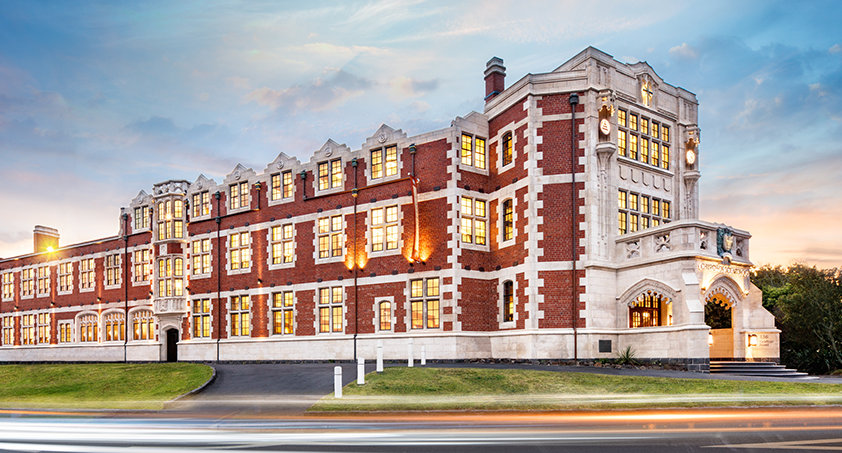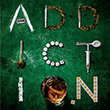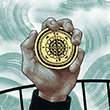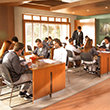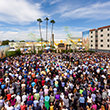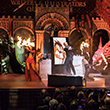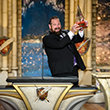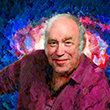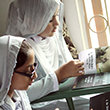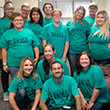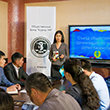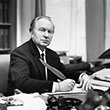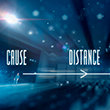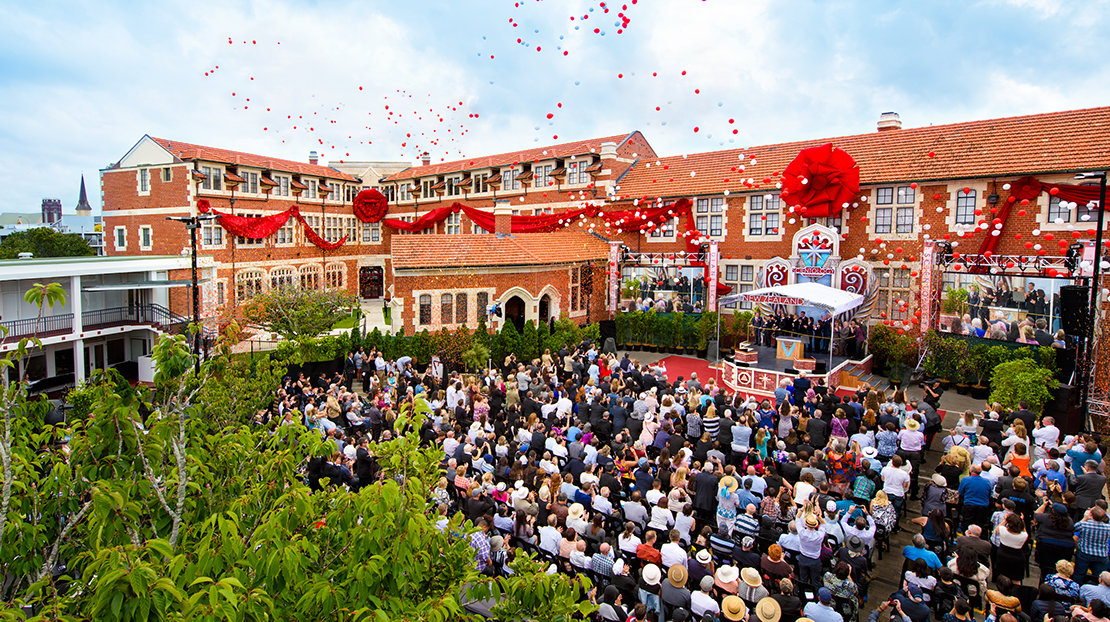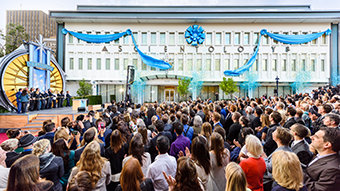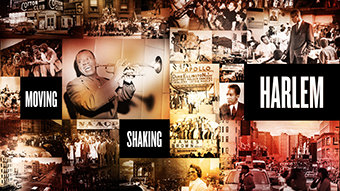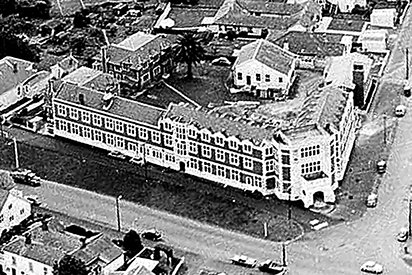
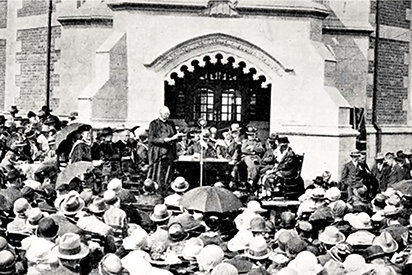
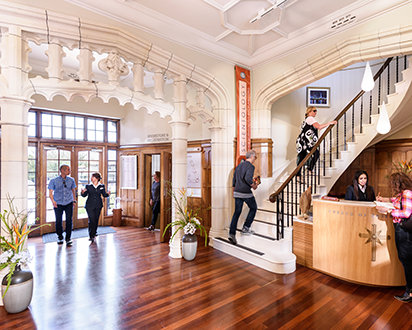
An onshore wind from the Tasman Sea rustled through the trees on the hillside above the famed Waitemata Harbour, as Maori Warden Mereana Peka mounted the stage for the opening ceremonies of Scientology’s new Church home in Auckland, New Zealand. Behind her, what was once the Trinity Methodist Theological College, now elegantly restored for the world’s second-oldest Scientology congregation, stood ready to open its doors.
Under lightly overcast skies, the day was as warm as the welcome Ms. Peka was about to give. With a crowd of Scientologists and guests looking on, she spoke of the wisdom of her people and a union with Scientology that illuminates a common spiritual purpose.
“In Maori we have a saying,” she said. “Ma rongo ka mohio, meaning, ‘if you hear, you will know;’ ma mohio ka matou: ‘from knowledge will come understanding;’ and ma matou ka ora: ‘from understanding will come healing.’
“For me,” she said, smiling broadly at the crowd, “Scientology represents the essence of those words. And so, from this day forward, we can begin the journey of reaching our ultimate potential.”
The opening of Scientology’s new Church on Saturday, January 21, 2017, marked a major milestone on that journey, and a renaissance as well for a Church that was founded here in 1955, well over half a century ago. Since that time, it has witnessed steady growth that has made its former facilities insufficient to needs, resulting in a rebirth reflected in the magnificently-restored historical landmark that continues the New Zealand Church’s long history of spirituality, education and tradition.
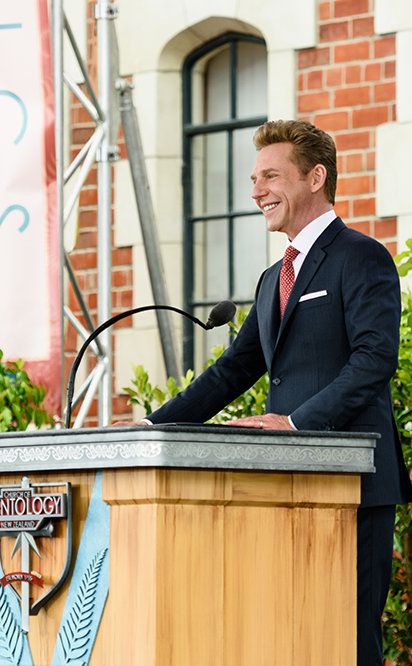
“We do not regard Church buildings as ‘buildings’, per se. Rather, we regard our buildings as ‘vessels for life’ and the living breathing fabric of their communities.” —Scientology ecclesiastical leader Mr. David Miscavige
These are the pillars on which Scientology’s new National Church of New Zealand now stands, the foundation for what has become a major part of the organization’s largest worldwide expansion in history, culminating in some 11,000 churches, missions and groups internationally.
Overlooking the “City of Sails” which dot Auckland’s magnificent Waitemata Harbour and the Tasman Sea, this local historic site and cherished landmark has been preserved and meticulously restored by the Church in cooperation with local architects and preservationists. It is a resurrection of what had been, in the building’s earlier incarnation, home to spiritual training for thousands of ministers and religious scholars for nearly half a century.
In 1927—90 years ago this year—Trinity Methodist Theological College first opened its doors at 136 Grafton Road to train theologians of the Christian faith. They would later carry their own missions throughout the Pacific Rim.
In its newest incarnation, as a spiritual center for Scientologists of all New Zealand, it brings full circle the ideas of faith and spirituality under the tenets of Scientology’s goals to create a world free of war and poverty, and committed to humanitarian aims.
With a ceremony that included Maori dancers, singers and traditional music, and a welcome from local officials and community leaders, the new Church of Scientology opened its doors for what will not only house the Church’s spiritual missions, but its vigorous humanitarian outreach programs, including drug education and human rights, all of which have already been at work in the nation for decades.
One such program, Criminon—the international criminal reform program sponsored by Scientologists—was conceived and started in New Zealand in 1972. Criminon’s extensive inspections of the nation’s prisons and criminal reform resulted in their publication, People in Cages—the Solution that Failed, providing the short history of prisons and penal reform in New Zealand, and it is still used to this day.
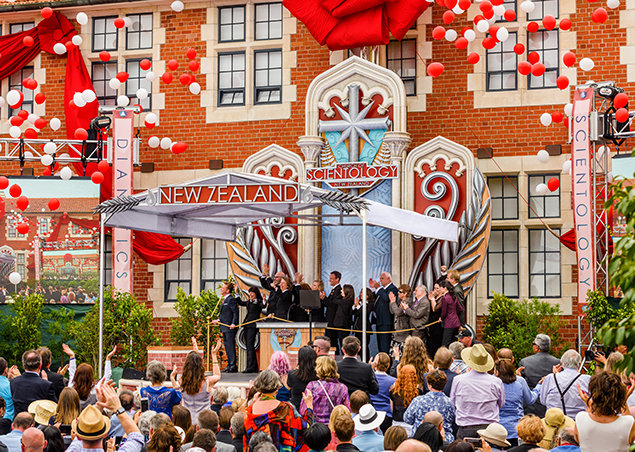
PAST, PRESENT AND FUTURE
The building in which the new Church is housed—a familiar landmark to all Aucklanders, and visible from most parts of the city—was reconstructed with a careful eye to historic preservation, and guidance from local officials who praised the Church for the care that went into the project.
Robin Byron, architect advisor to Heritage New Zealand, said the project has also marked a milestone for the community as well.
“Auckland is defined by heritage buildings that tell the story of this city,” she told the assembled crowd. “They link us to our early pioneers: the entrepreneurs, the educators, doctors, scientists and religious leaders. They recall the people and events that shaped Auckland’s history. Historic buildings connect us to our ancestry and maintain continuity, from our past to our present, and to our future.”
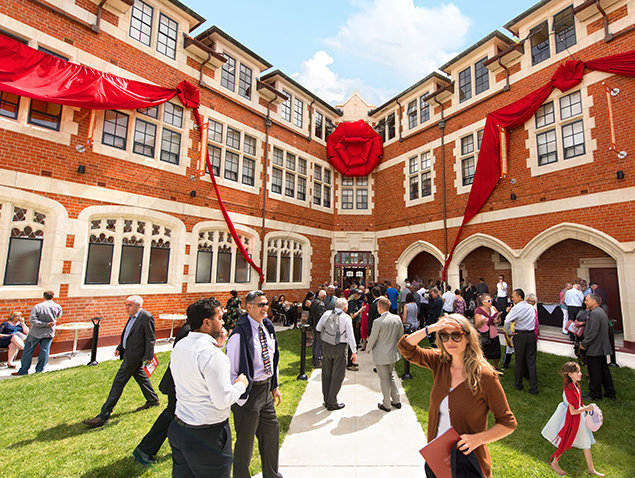
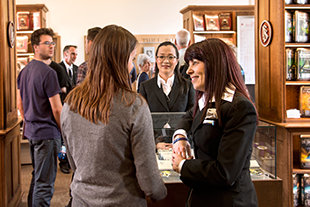
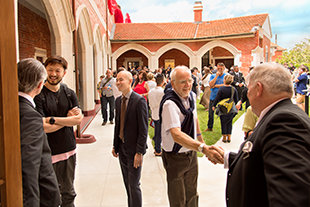
Mr. David Miscavige, ecclesiastical leader of the Scientology religion, who was joined by honored local guests to officially open the doors of the new Church, said the significance of its history and its hilltop overlook along Auckland’s volcanic landscape all speak well to its future.
“We do not regard Church buildings as ‘buildings’, per se,” he told the enthusiastic crowd. “Rather, we regard our buildings as ‘vessels for life’ and the living breathing fabric of their communities. Consequently, when we bring spiritual beings back to life by restoring their own sense of spirituality—so a Church itself comes to life. And, so we thank Auckland for allowing us to serve as custodians of a Church that’s just as much New Zealand’s as ours.”
The January opening of the Church brought together a spirit of community cooperation. It is an illustration of Scientology’s commitment to that community, demonstrated by helping preserve the heritage of Auckland’s Grafton neighborhood, and returning the building to its former grandeur in what local church leaders have described as honoring an “unbroken heritage as a place of enlightenment and spiritual knowledge.”
Local state and community leaders and individuals involved in Scientology’s many secular humanitarian missions in New Zealand, and who spoke at the grand opening, made note of the significance of the Church’s ever-expanding missions within the country.
Byron told the participants that the melding of past and present within the restored facility offers “a particularly satisfying parallel, that, as first conceived for the purpose of religious learning and guidance, this historic landmark is now experiencing a spiritual renaissance as the new home of the Church of Scientology in Auckland.
“Your dedication in taking on the restoration of this heritage jewel has been very memorable,” she said. “The building had seen many years of neglect and so this endeavor represented no small commitment. But you appreciated the richness of the history within these walls, caring for the precious materials and their fine craftsmanship.”
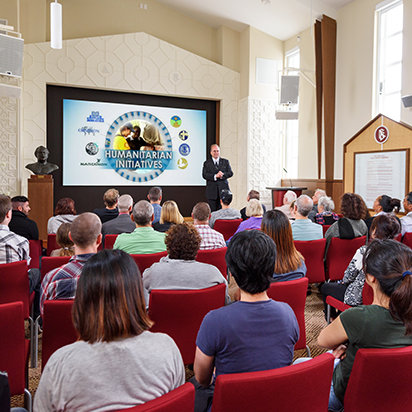
From the red brick and white Oamaru stone fabric used across the façade, to the restoration of the delicately and carefully finished oak in the entrance hall and library, to the preservation of rimu timber paneling and jarrah wood flooring, the reconstruction has set the facility apart as a work of art itself.
But it represents far more to a community that has seen the Church’s human rights, social justice, education and anti-drug programs make a difference already in the lives of young people and adults in Auckland. That work will now expand through the work of volunteers and some 100 staff and executives, many of them trained at Scientology’s home Church in Los Angeles.
Yvonne Galvin, advisor to the Youth Crime Prevention program of New Zealand’s Ministry of Justice, said she sees special new opportunities stemming from the Church’s expansion.
“Today, my cause is taking care of youth at risk in the justice system,” she told members and guests. “When I first joined the system and I saw how youth were being treated, I said to myself: ‘I’ve got to find out something about human rights.’ But I couldn’t find anybody doing anything about it.
“Then I heard of the Church of Scientology and your volunteers,” she said. “So, I drove across town to find you, and when I did, I remember I told you: ‘I want that rights program that you do!’ And that’s how we started a united movement to teach human rights to Auckland youth.”
That work has had parallels for Thomas Henry as well. As a top advisor to the New Zealand Police Department he has become a tireless advocate against the abuse of street drugs and psychiatric medications, and a just-as-tireless advocate for creation of more responsible mental health care operations within the nation.
“I deal with families who have been promised the easy ‘solution’ of psychiatric drugs and labels as a quick fix,” he said. “And ultimately they are left dependent and further in trouble. I’ve seen this my entire life.
“In my experience, all too often the real reasons behind mental and spiritual issues are ignored.
“The actual problem is that people don’t know anything about psychiatry and mental health until it affects them personally,” he noted. “But after finding the Citizens Commission on Human Rights, we were no longer left in the dark, because there is a voice in the dark. It leads to the light, and that voice is CCHR.”
Henry said that his experience with the Church has helped him reach more people in need, affect more lives, and bring new understanding to challenges that New Zealanders face in helping others.
“I know this Church of Scientology will be a place of education where people can come and where people can talk,” he said. “Here, they are going to know they’re being heard, and that they can learn and become better people. And I know this Church will touch the spirits of many Aucklanders across New Zealand.”
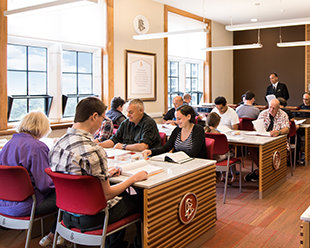
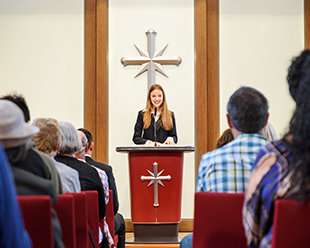
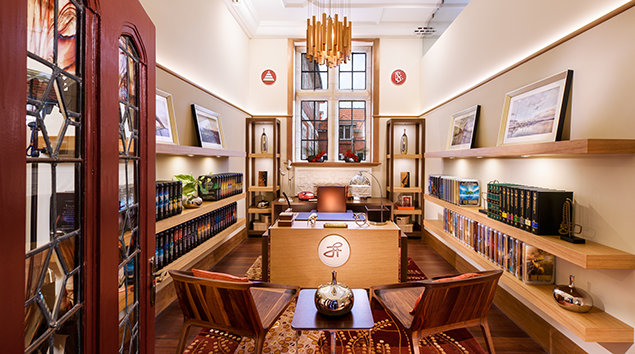
The spiritual and educational heritage of these new grounds—the building was also home to New Zealand state educational apparatus in the 1970s and once housed a design and art school as well—will see in the restored Church facility a revival of opportunities to continue learning, teaching and spiritual outreach.
Since the first Church of Scientology in New Zealand opened in 1955, its growth and expansion over the intervening 62 years has been a realization of Scientology Founder L. Ron Hubbard’s vision for the Church and its work within the region. It held a special place in Church history since its inception, and the move into the elegant new campus and buildings has brought that uniqueness into a new era.
The technologically advanced Information Center within the facility offers now some 500 films and countless other materials detailing the Founder’s work and the Church’s position in the world’s spiritual landscape. Materials also describe the Church’s sponsorship of humanitarian initiatives and community outreach programs, and offer parishioners and volunteers opportunities to participate in those works. Scientology’s global network of literacy and learning centers; worldwide drug education, prevention and rehabilitation; far-ranging human rights efforts; and the Scientology Volunteer Minister program are all accessible through these new facilities.
The Church’s new home will be the center for the delivery of all Scientology Introductory Services, including evening and weekend Dianetics and Scientology seminars, which offer an overview of fundamental principles and how those principles are applied to daily lives. An array of Scientology Life Improvement Courses complement the introduction material to help better all aspects of individuals’ lives.
Ms. Peka summed up those opportunities.
“In the current society, our people are hurting,” she said. “And for some, it’s very hard to even start thinking about solutions—it’s just a huge problem for all of us. But you have absolutely basic life skills to give. And this new Church of Scientology in Auckland is a major stepping-stone for us to heal within ourselves and in our communities.”
Mr. Miscavige said that he sees here yet another bright light in what has been a period of unprecedented expansion of the Scientology religion. Standing before the crowd within the campus green, he lauded the local achievement and dedication of those who brought the facility into the universe of Scientology’s worldwide mission.
“This mystic isle where Kiwis and Aussies formed an awesome alliance, where you wanted what stands before us as much as you wanted life—well, you got it,” Mr. Miscavige said. “And all the heavenly signs now agree: That new star in your Southern Cross shines for this new National Church of Scientology, New Zealand.”
